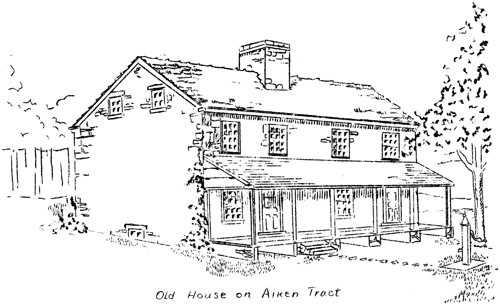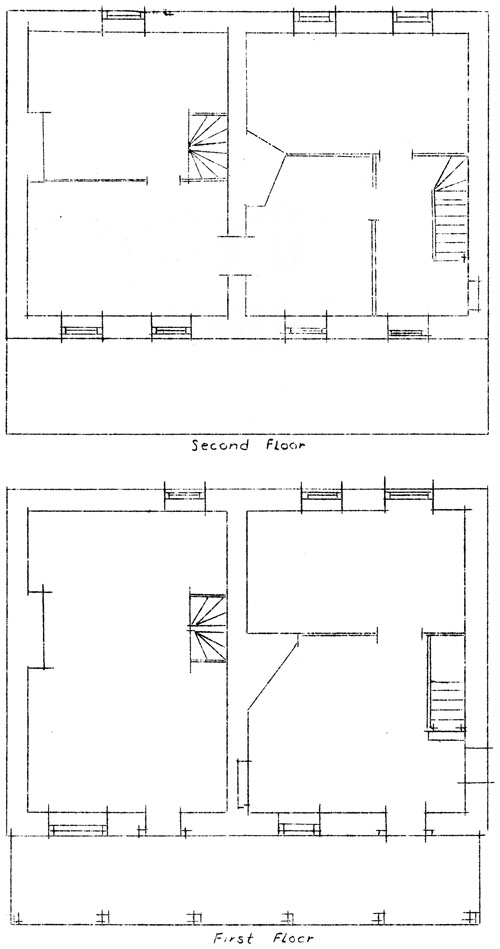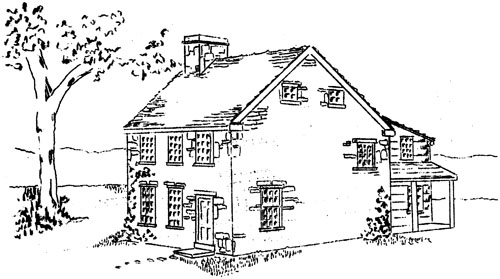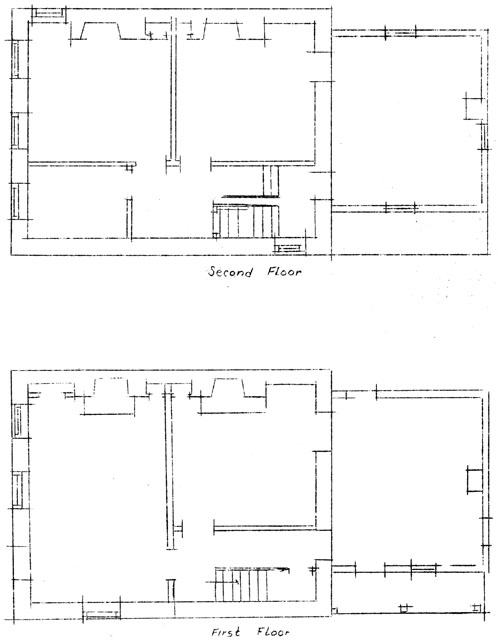|
Home : Quarterly Archives : Volume 1 |
Tredyffrin Easttown Historical Society |
|
Source: April 1938 Volume 1 Number 3, Pages 14–19 Local titles in Easttown and Tredyffrin: Part A – by Howard S. Okie On April 1, 1814, William Neill of Tredyffrin, tobacconist, and his wife Margaret, conveyed to James Gamble of the township of Westtown, tobacconist, a messuage and land in Easttown -- Beginning at a stake in line of lands of William Neill and John Rees and extending along the lands of said Rees North 50 1/2 degrees East 22 perches, along the South side of the Turnpike North 75 1/2 degrees East 7.85 perches, along a road the boundary of lands late of Wm. Torbet South 35 1/2 degrees East 47.2 perches, along other lands of Wm. Neill South 49 1/2 degrees West 36.56 perches and North 28 degrees West 52.2 perches to beginning. Containing 10 acres and 50 perches. I-3-409. This tract was on the Lancaster Turnpike frontage or northern portion of the piece of 18 acres and 57 perches sold in 1813 by James Morris, Senior, to Wm. Neill by I-3-48, referred to in the article on the Mary A. Lewis tract. Its location will be clear from the somewhat crude plans there shown which have been taken mainly from an old brief of the title to that property. The title came down to Thomas Aiken by three conveyances: 1833. Peter Osborne, Sheriff, to William. Gamble, premises of James Gamble, deceased, in possession of Sarah Gamble his administratrix, for the consideration of $1970. Described as - Messuage and tract of land in Easttown bounded by lands of Henry Carter, John Rees and others. Containing 10 acres. 1856. Lewis Heffelfinger, Sheriff, to Samuel White on proceedings by Mary Reese and William H. Reese, Executors of David Reese, against premises of William Gamble. Described as - "messuage two tenements" and land in Village of Reeseville, Easttown township, bounded by Philadelphia and Lancaster Turnpike, lands of Henry Carter, John Kugler and others. Containing 10 acres and 52 perches." D-6-206.
Old house on Aiken tract 1870. Samuel Whites of Easttown to Thomas Aiken of Tredyffrin, by U-7-267 for $6150. "Messuage or two tenements" in Easttown, beginning at a stone in the line of land late of Henry Carter, deceased, by the same North 54 degrees East 36.64 perches to the middle of a public road, along tho same North 32 1/2 degrees West 51.32 perches to a stake on the south side of the Pennsylvania Railroad, by land of Henry Fritz being also the line between the townships of Easttown and Tredyffrin South 56 1/2 degrees West 30.44 perches to a stake on the south side of said railroad, thence along the same Carter's land South 25 degrees East 52.44 perches to beginning. Containing 10 acres and 126 perches.
Second floor, First floor
Part B – by Mary Gurney Croasdale (In Collaboration with Mr. Franklin L. Burns) Roads change, communities grow up, and with the necessary moving of lines, landmarks are taken away or are hidden from sight. Soon there is nothing left of the beautiful old places. As we hurry a little faster, now, along the Lincoln Highway in Berwyn -- going west from the railroad station to the upper bridge there is little enough indication of the way things were a hundred years ago. In one unpromising looking spot there is a surprise. The old houses are still there. On our left there is Waterloo Road, the eastern boundary of the old Aiken farm. Along the Highway there is the bake-shop, concealing a landmark, there is the shoemaker's shop, then Mr. Garber's, then Hickman's and so forth. All that and much more was the Aiken farm. Now, cut through by avenues, Berwyn, Knox, Woodbine and Aiken, and containing many houses and shops, it was once a complete little farm of about ten acres. Directly in front of the original houses shop fronts have been built, but if you go into the alley, or by Mr. Garbor's kindness, through his store, you can see the old stone houses and can picture the way it all used to be.
Second floor, First floor Mr. Garber now owns the western house, a double one, not large, but beautiful in simplicity. The western end is evidently the older since there are walled up windows facing east. This end is of old stone, simply pointed. The other side has been covered with plaster. In the early days the house was a cigar factory, managed by the Neills, then by the Gambles. They made "Spanish" and "Half-Spanish segars" of the slender Pittsburg stogie kind. The "Spanish segar" was made wholly of Havana leaf and retailed at a penny apiece. The "Half- Spanish" was of domestic tobacco, probably grown on the farm, it was wrapped in Havana leaf and sold two for a penny. With the busy Highway there now and the deep, ugly railroad cut it is not easy to see the way that pleasant little place looked, with its trees and whitewashed fences, all a characteristic part of the pretty village of Reeseville. Miss Anna White and her sister and brother, who live now near Howellville remember visiting the eastern house, the single, one, now quite eclipsed from the north by the bake shop. They remember it as the larger of the two. The Whites came, as children, to see their grandfather, who lived there. This house is also stone, plaster covered. There was a pump in front and a horse-trough and we have a Civil War story connected with that. General Lee had invaded the Commonwealth of Pennsylvania. One day Union soldiers passed by, returning, perhaps, from Gettysburg. They were tired and their blue clothes were grey with dust. This dust fooled a local "Copperhead" who rashly let his Southern sympathies run away with his discretion. He shouted "Hurrah for Jeff Davis" and he was promptly doused in the horse-trough. As it used to be, only the Lancaster Turnpike was in front. About 1830 the railroad came and, later, about 1876-8 when the railroad was straightened, it was bad for the old houses. New foundations were made and the stone buildings were moved south about 50 feet. Enoch Wells was living in one house at moving time. He was promised that he should not be disturbed. It must have been something to see. They did it with jacks, nicely squared, well soaped oak timbers, a windlass and a horse. It was well done; a glass brim full of water, placed on a window sill, never spilled a drop. There is no sign now of the old barn. It must have been simpler to destroy it. Seldom can stone houses boast of being from fifty to seventy-five years older than their foundations. The deep dug well they could not move. It had been the sole water supply for both houses and the barn for many years. It remained in use in its unique position at the verge of the deep railroad cut until the Springfield Water Company laid its mains. Then Mr. Garber dropped the pump into the well and closed the opening. The old deeds, carefully drawn and read give us the boundaries. The names, Aiken, Gamble, White, and the others are known and respected by all of us, but memories slip, trees and whitewashed fences give way to traffic. Unless we are diligent in our time much that is of real value is sure to be lost. I wish some benefactor would restore the two old houses on the Aiken farm. |



